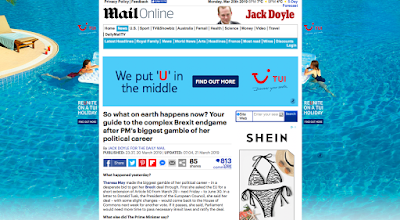Different Opinions - News Revision
Both articles address the prominent matter of Brexit and Theresa May's downfall regarding Article 50 and her statement from 10 Downing Street. Though The Guardian supposedly takes a more liberal and unbiased stance in their articles, this opinion piece by Marina Hyde clearly demonstrates a hatred for Theresa May with her implied incompetence and her 'various lunacies' regarding the extension of article 50. Unconventionally Hyde uses colloquial and taboo language which contrasts from the use of such language due to The Guardian's high brow audience yet the use of this language arguably shows the passion in the subject and does not weaken the argument or make it appear farcical. The Daily Mail surprisingly creates a more factual article with less personalisation through use of the passive voice yet uses rhetorical questions as headlines and fillers to construct the article which allows the audience to place their own views into the article whilst also allowing them to feel as though their ideologies are being matched by the Daily Mail's views. Unlike Hyde (who uses many personal pronouns throughout her article), journalist Jack Doyle does not form a heavily opinionated piece which is unconventional for the Daily Mail which usually takes a right-wing stance in their articles so it is therefore surprising to see little personalisation in an article predominantly relating to Brexit.
Both articles feature the same video of Theresa May giving a speech regarding the delay of Brexit which illustrates the importance of the speech. Unlike the Guardian, the Daily Mail has also used a graphic diagram illustrating 'what will happen with Brexit next week' which creates a comedic element to the piece as the illustration is rather basic and child-like with the flow-chart structure which arguably mirrors the BC1C2D demographic of the audience. The Daily Mail also features an image of May behind a metal gate in a paparazzi style which conveys the newspapers typical celebrity journalism articles. This furthermore links to the other articles linked to the right hand side of the page which focalise on celebrities (particularly female celebrities showing elements of the male gaze). The Guardian juxtaposes this and links articles that relate to Brexit and Theresa May such as 'Brexit petition to revoke article 50 exceeds 5m signatures'.
For the Daily Mail there are many adverts on the page as shown above with an extremely large advert relating to TUI holidays taking up a lot of space along with smaller adverts relating to bikinis available to buy (arguably illustrating the scary reality of cookies and tailoring of search history-based adverts (more sinister response of 'big brother is watching you' as a homage to Orwell's 1984)). The Guardian contrastingly features an advert relating to their own dating site 'soul mates'.
Above the comment section shows how each newspaper is appealing to its target audience as the comments differ between the two articles. In the Daily Mail the comments are arguably shorter but more opinionated as the commenters give their opinion in a low-brow manner through elliptical sentences. The Guardian however appears to target their higher demographic audience of ABC1 which is made evident by their explanatory comments (perhaps with the exception of the second comment).









Comments
Post a Comment